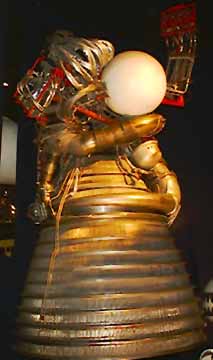|
Engines and Boosters
The rocket's engines supply the thrust or push that drives the rocket forward. The rocket engine is described as a reaction motor, for it works by ejecting or thowing out mass - hot, fast-moving gasses in this case. This creates what is known as a reaction force in the opposite direction to that in which the gas is moving. This reaction force accelerates the rocket motor and hence the rocket.
More information about the physics is contained in Newton's Motions.
Two main types of rocket engine exist.
Solid-Fuel Rocket Engines
The simplest, cheapest and most common type of rocket engine is the solid-fuel motor. This consists of a casing which contains solid fuel propellant, and a nozzle. The propellant simply requires ignition for it to work. It is usually made of material based on black powder (gun powder), but more sophisticated modern materials are used in motors for the space programmes.
Solid fuel engines are used in fireworks and model rockets at one end of the size range, and as Space Shuttle boosters at the other end. Once fired a solid rocket is largely useless. It is usually not re-usable, and for that reason disposable materials such as cardboard, are often used in small rocket engines. Larger engines, such as the Shuttle's boosters can be re-used, but they do need a lot of re-conditioning first.
The main problem with solid fuel motors is that they are uncontrollable once lit. They are almost impossible to extinguish and the amount of thrust they produce cannot be varied. Most solid fuel motors burn furiously for a very short period, giving very high thrust to mass ratios. They are therefore useful in accelerating a rocket in the early stages of flight, but you can only use them once. With large rockets, as soon as the fuel is burnt the spent engine cases or boosters are nearly always jettisoned to save weight and improve efficiency.
Liquid-Fuel Rocket Engines
 The other type of rocket engine is the liquid propellant motor. This consists, in basic terms, of a combustion chamber, a nozzle, fuel pumps, fuel leads, fuel injectors and an ignition system. In addition, such motors can have a control system which is capable of varying the engine thrust, and gimbels which can vary the direction of the thrust. These either move the entire engine unit or the nozzle. The other type of rocket engine is the liquid propellant motor. This consists, in basic terms, of a combustion chamber, a nozzle, fuel pumps, fuel leads, fuel injectors and an ignition system. In addition, such motors can have a control system which is capable of varying the engine thrust, and gimbels which can vary the direction of the thrust. These either move the entire engine unit or the nozzle.
This type of rocket engine is a complex and expensive piece of engineering and is usually only built and used on spacecraft or military hardware. The engines are controllable, both in thrust output and in burn-time. They are reusable and can be turned on or off at will. Large liquid propellant motors are used as the main engines on most launch vehicles now. They are also common in upper stages of rockets and as apogee boost motors to place satellites in orbit or send spacecraft on a trans-planetary trajectory. Small and very small liquid fuel motors are used as manoeuvring engines in satellites and spacecraft, too.
The main problem with liquid fuel is its volatility. It can be corrosive, poisonous and very cold as well as being highly flammable. Care must be taken with its storage and handling to prevent accidents.
Liquid fuel engines work by combusting two substances that burn well when mixed and ignited. The consequential burning causes the creation of large amounts of gas in the combusion chamber under extremely high pressure. This rapidly expands through the nozzle at high speed, as was described with the solid propellant engine.
Boosters
Boosters are an alternative to Staging. They are just rockets of a special type, which are fixed to the main first stage to give additional power at take-off and in the early stages of flight. They are much cheaper than staging, and are usually solid-fuel powered. Staging and boosters are commonly used together to get the greatest efficiency from a rocket.
|













